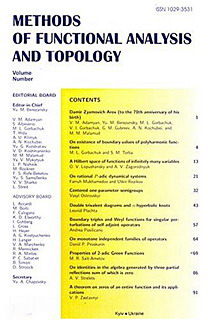Vol. 24 (2018), no. 3
Volodymyr Dmytrovych Koshmanenko (to 75th birthday anniversary)
MFAT 24 (2018), no. 3, 187-189
187-189
Yuii Stefanovych Samoilenko (to 75th birthday anniversary)
MFAT 24 (2018), no. 3, 190-192
190-192
On extensions of linear functionals with applications to non-symmetrically singular perturbations
Mykola Dudkin, Tetiana Vdovenko
MFAT 24 (2018), no. 3, 193-206
193-206
The article is devoted to extensions of linear functionals, generated by scalar products, in a scale of Hilbert spaces. Such extensions are used to consider non-symmetrically singular rank one perturbations of ${\mathcal H}_{-2}$-class. For comparison, we give main definitions and descriptions of singular non-symmetric perturbations of ${\mathcal H}_{-1}$ and ${\mathcal H}_{-2}$-classes.
Quasi-invariance of completely random measures
Habeebat O. Ibraheem, Eugene Lytvynov
MFAT 24 (2018), no. 3, 207-239
207-239
Let $X$ be a locally compact Polish space. Let $\mathbb K(X)$ denote the space of discrete Radon measures on $X$. Let $\mu$ be a completely random discrete measure on $X$, i.e., $\mu$ is (the distribution of) a completely random measure on $X$ that is concentrated on $\mathbb K(X)$. We consider the multiplicative (current) group $C_0(X\to\mathbb R_+)$ consisting of functions on $X$ that take values in $\mathbb R_+=(0,\infty)$ and are equal to 1 outside a compact set. Each element $\theta\in C_0(X\to\mathbb R_+)$ maps $\mathbb K(X)$ onto itself; more precisely, $\theta$ sends a discrete Radon measure $\sum_i s_i\delta_{x_i}$ to $\sum_i \theta(s_i)s_i\delta_{x_i}$. Thus, elements of $C_0(X\to\mathbb R_+)$ transform the weights of discrete Radon measures. We study conditions under which the measure $\mu$ is quasi-invariant under the action of the current group $C_0(X\to\mathbb R_+)$ and consider several classes of examples. We further assume that $X=\mathbb R^d$ and consider the group of local diffeomorphisms $\operatorname{Diff}_0(X)$. Elements of this group also map $\mathbb K(X)$ onto itself. More precisely, a diffeomorphism $\varphi\in \operatorname{Diff}_0(X)$ sends a discrete Radon measure $\sum_i s_i\delta_{x_i}$ to $\sum_i s_i\delta_{\varphi(x_i)}$. Thus, diffeomorphisms from $\operatorname{Diff}_0(X)$ transform the atoms of discrete Radon measures. We study quasi-invariance of $\mu$ under the action of $\operatorname{Diff}_0(X)$. We finally consider the semidirect product $\mathfrak G:=\operatorname{Diff}_0(X)\times C_0(X\to \mathbb R_+)$ and study conditions of quasi-invariance and partial quasi-invariance of $\mu$ under the action of $\mathfrak G$.
Schrödinger operators with measure-valued potentials: semiboundedness and spectrum
Vladimir Mikhailets, Volodymyr Molyboga
MFAT 24 (2018), no. 3, 240-254
240-254
We study 1-D Schrödinger operators in the Hilbert space $L^{2}(\mathbb{R})$ a with real-valued Radon measure $q'(x)$, $q\in \mathrm{BV}_{loc}(\mathbb{R})$ as potentials. New sufficient conditions for minimal operators to be bounded below and selfadjoint are found. For such operators, a criterion for discreteness of the spectrum is proved, which generalizes Molchanov's, Brinck's, and the Albeverio-Kostenko-Malamud criteria. The quadratic forms corresponding to the investigated operators are described.
On uniqueness of fixed points of quadratic stochastic operators on a 2D simplex
MFAT 24 (2018), no. 3, 255-264
255-264
The Perron--Frobenius theorem states that a linear stochastic operator associated with a positive square stochastic matrix has a unique fixed point in the simplex and it is strongly ergodic to that fixed point. However, in general, the similar result for quadratic stochastic operators associated with positive cubic stochastic matrices does not hold true. Namely, it may have more than one fixed point in the simplex. Moreover, the uniqueness of fixed points does not imply the strong ergodicity of quadratic stochastic operators. In this paper, for some classes of positive cubic stochastic matrices, we provide a uniqueness criterion for fixed points of quadratic stochastic operators acting on a 2D simplex. Some supporting examples are also presented.
On the spectrum of multiplication operators
MFAT 24 (2018), no. 3, 265-274
265-274
We study relations between spectra of two operators that are connected to each other through some intertwining conditions. As an application, we obtain new results on the spectra of multiplication operators on $B(\mathcal H)$ relating it to the spectra of the restriction of the operators to the ideal $\mathcal C_2$ of Hilbert-Schmidt operators. We also solve one of the problems, posed in [6], about the positivity of the spectrum of multiplication operators with positive operator coefficients when the coefficients on one side commute. Using the Wiener-Pitt phenomena we show that the spectrum of a multiplication operator with normal coefficients satisfying the Haagerup condition might be strictly larger than the spectrum of its restriction to $\mathcal C_2$.
Fractional kinetics in a spatial ecology model
José Luís da Silva, Yuri Kondratiev, Pasha Tkachov
MFAT 24 (2018), no. 3, 275-287
275-287
In this paper we study the effect of subordination to the solution of a model of spatial ecology in terms of the evolution density. The asymptotic behavior of the subordinated solution for different rates of spatial propagation is studied. The difference between subordinated solutions to non-linear equations with classical time derivative and solutions to non-linear equation with fractional time derivative is discussed.
On new points of the discrete spectrum under singular perturbations
MFAT 24 (2018), no. 3, 288-296
288-296
We study the emergence problem of new points in the discrete spectrum under singular perturbations of a positive operator. We start with the sequential approach to construction of additional eigenvalues for perturbed operators, which was produced by V. Koshmanenko on the base of rigged Hilbert spaces methods. Two new observations are established. We show that one can construct a point of the discrete spectrum of any finite multiplicity in a single step. And that the method of rigged Hilbert spaces admits an application to the modified construction of a new point of the discrete spectrum under super-singular perturbations.


